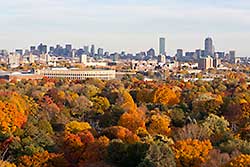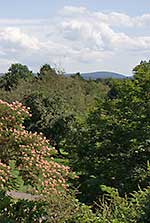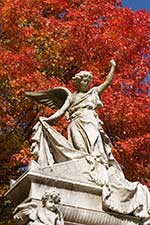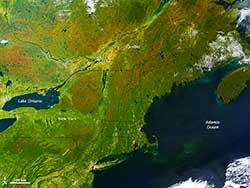Where Autumn Colors Come From.

Days are getting shorter and nights cooler, and our New England trees are putting on glorious cloaks of yellow, orange and scarlet. Why? And where do all those colors come from?
A leaf’s color comes from the materials it contains. Some are green, others red, brown, yellow, orange and violet. Some are always present, others only at certain times. The mix changes as the seasons progress, and with it the colors we see.
Why Are Leaves Usually Green? Remember the science lesson on photosynthesis? Light helps plants convert carbon dioxide and water into oxygen and sugar. Chlorophyll is essential to this process and it is green.

Chlorophyll is produced all summer to support flowering and growth. In a healthy plant, its green pigment is so abundant that it overpowers the colors of other materials in the leaves.
What Happens in the Fall? Chlorophyll production slows and eventually stops as plants get ready for winter. As it does, colors that were overpowered by green all summer begin to emerge. Joining them are the colors of new substances produced in the Fall as the tree gets ready of winter.

Yellow and Orange. These come from Carotenoids, which are present all summer and help with photosynthesis. They also give corn, carrots and bananas their color and account for the yellow color of sick leaves, where chlorophyll production has slowed.
Brown. Comes from tannins, which also are hidden all summer. Tannins help protect plants from pests and may regulate growth.
Pink, Purple and Red. These colors come from anthocyanins and are usually produced only in the autumn.
What Prompts Color Change? It’s somewhat of a mystery. Most explanations are based more on anecdotal evidence than hard scientific research. Temperature and hours of sunlight appear to be key factors, but their importance seems to vary by region and species.
Genetic differences play a role as well. Maples, for example, tend to be among the first to change and oaks the last.
Why colors are “better” some years than others is also open to conjecture. Warm, sunny autumn days and cool, crisp nights seem to create the best display, but spring and summer moisture, cool and warm spells also appear to influence the result.

Why Are Some Trees Red in Spring? Some trees change color in the spring, displaying brilliant red leaves before they turn green. The reason is green chlorophyll again — those trees simply are slow to produce it, allowing “autumn” colors to shine through in the meantime.
How Will Global Warming Affect Seasonal Patterns? Research is just beginning. A U.S. Forest Service study suggests that trees might migrate, following the temperature ranges they are accustomed to.2 Princeton researchers believe that color change may start later and last longer.3 The bottom line is we probably really won’t know until it happens.
* * * * *
Enjoy nature’s annual pageant.
-----
- Image taken September 27, 2014 by NASA’s Terra satellite and adjusted in Photoshop to emphasize colors. Original image on NASA’s web site.
- Christopher W. Woodall, Study Suggests Tree Ranges Are Already Shifting Due to Climate Change, 2010. Copy available at U.S.D.A. Forest Service web site.
- Wendy Plump, Fall foliage season may be later, but longer on warmer Earth, Princeton Environmental Institute, Sept. 18, 2014. The full study is published in Global Ecology and Biogeography.
This article originally appeared in our free semi-monthly newsletter. To receive future issues, please add your name to the subscription list.

